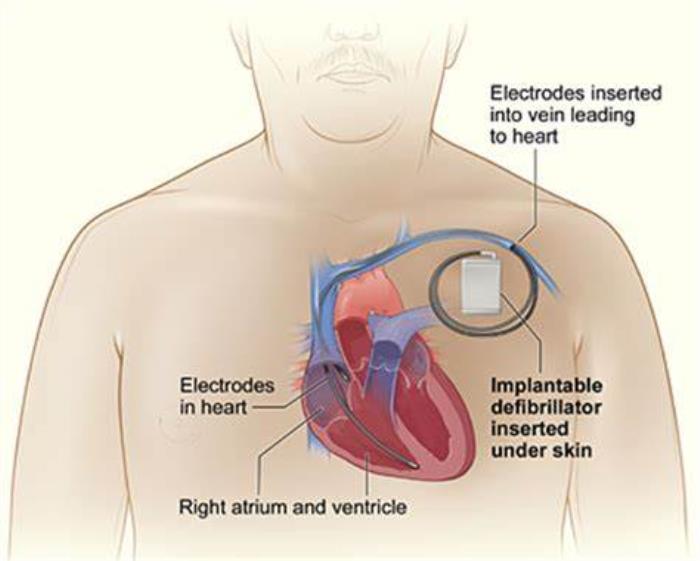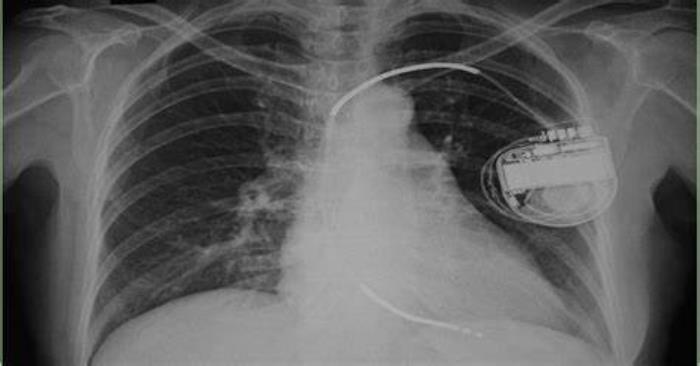The battery life of an Automated Implantable Cardioverter Defibrillator (AICD) is a crucial component in ensuring that the device functions optimally. Since the AICD continuously monitors heart rhythms and can deliver shocks when necessary, maintaining its battery is essential for patients relying on the device for protection against life-threatening arrhythmias. Understanding how long the battery lasts, factors that influence its lifespan, and how to monitor and maintain its health are key elements for AICD patients to ensure they are always protected.
What Is an AICD Device and How Does It Work?
An Automated Implantable Cardioverter Defibrillator (AICD) is a small, surgically implanted device designed to monitor and treat abnormal heart rhythms, such as ventricular tachycardia and fibrillation. It is equipped with sensors to detect irregular rhythms and, when needed, administer electrical shocks to restore a normal heart rhythm. This device offers lifesaving protection for patients at risk of sudden cardiac arrest due to these arrhythmias, functioning continuously to protect the heart and maintain normal rhythm.
How Long Does the Battery of an AICD Last?
The battery life of an AICD typically lasts between 5 to 10 years, depending on factors such as the device model, the frequency of its use, and the patient’s heart condition. Devices that are frequently activated to deliver shocks or pacing may experience a shorter battery life. Most AICDs have a low-power mode that helps extend battery life, but the exact lifespan varies between patients. It’s essential for patients to understand the expected duration of their device’s battery and the importance of monitoring it regularly.

Factors That Affect the Battery Life of an AICD
Several factors can affect the battery life of an AICD. The frequency with which the device delivers shocks or pacing signals is one of the most significant factors, as more frequent activations can deplete the battery faster. The type and model of the AICD also play a role, with newer models often designed to be more energy-efficient. Additionally, the patient’s heart condition, lifestyle, and adherence to device maintenance can impact battery longevity. Regular monitoring and checkups with the cardiologist can help track battery health and plan for timely replacements.
Signs That Indicate Your AICD Battery May Need Replacement
There are several signs that may indicate an AICD’s battery is nearing the end of its life. These include a warning from the device itself, which is typically communicated during regular checkups, or specific alerts sent to the healthcare provider. In some cases, the patient may experience a feeling of dizziness or palpitations if the device is not functioning optimally. If any unusual symptoms or alerts occur, it’s crucial to seek medical advice immediately to evaluate the battery’s status and determine if replacement is needed.
How to Monitor Your AICD Battery Life at Home
Most modern AICDs allow patients to monitor their battery life through a home monitoring system or remote device that regularly transmits data to the healthcare provider. This system can help detect when the battery is low and notify the patient ahead of time. Some AICD models may also have an indicator light or alerts on a handheld device that shows the battery’s remaining life. However, regular checkups with the cardiologist are necessary to ensure the device’s battery is functioning properly and to track its usage accurately.
The Role of Regular Checkups in Managing AICD Battery Health
Regular checkups with a cardiologist are essential for managing the health of an AICD and ensuring that the battery is functioning well. During these visits, the device is monitored, and data is reviewed to assess battery status, device function, and overall heart health. The cardiologist will also check for any signs that the battery is approaching the end of its lifespan. Early detection of battery depletion allows for timely replacement, avoiding potential malfunctions and ensuring that the device continues to provide the necessary protection against arrhythmias.
What Happens When the AICD Battery Runs Out?
When the battery in an AICD (Automated Implantable Cardioverter Defibrillator) runs out, the device can no longer deliver shocks or pacing to the heart as needed. This can put patients at risk, especially those who rely on the device to manage life-threatening arrhythmias. As the battery nears depletion, the device will typically send signals to the patient or healthcare provider, alerting them to the need for a battery replacement.
The Process of Replacing an AICD Device Battery
Replacing the battery of an AICD is a relatively straightforward procedure but requires careful planning. The procedure typically involves a small incision over the existing AICD implant site. The old battery is removed, and a new one is implanted in the same location, ensuring that the leads (wires) are properly connected and functioning. The procedure is usually performed under local anesthesia and sedation.
Risks and Complications of AICD Battery Replacement Surgery
While AICD battery replacement surgery is generally safe, there are some risks involved, including infection, bleeding, and damage to the heart's electrical system. In some cases, patients may experience swelling, bruising, or discomfort at the incision site. Rarely, complications like lead displacement or damage to surrounding tissue may occur, which may require additional interventions.
What to Expect During an AICD Battery Replacement Procedure
During an AICD battery replacement procedure, patients are typically awake but sedated. Local anesthesia numbs the incision site, and the surgeon will remove the old device, replace the battery, and ensure that the leads are properly connected. The procedure usually takes one to two hours, and patients are monitored afterward for any immediate complications before being sent home.
How Often Should You Have Your AICD Battery Checked?
AICD batteries should be checked regularly as part of routine follow-up appointments with your cardiologist or electrophysiologist. Depending on the device's usage and the type of battery, a check is typically recommended every 3 to 6 months. Some devices also allow for remote monitoring, so patients can keep track of their device's status at home.

The Importance of Telemonitoring for AICD Patients
Telemonitoring allows patients with AICDs to have their device's battery life and function checked remotely. This helps to detect any issues before they become critical and reduces the need for frequent in-person visits. Remote monitoring can provide peace of mind by ensuring that the device is functioning correctly and battery life is sufficient.
Technological Advances in AICD Battery Life
Advancements in AICD technology have led to longer-lasting batteries and improved energy efficiency. Newer devices are designed to last for up to 10 years or longer, depending on the patient's needs and the frequency of device use. Innovations like energy-saving modes and more efficient circuitry help extend battery life while reducing the frequency of replacements.
How to Extend the Battery Life of Your AICD Device
Patients can help extend the battery life of their AICD device by avoiding unnecessary shocks, maintaining a healthy lifestyle, and ensuring that their device is programmed for optimal energy use. Avoiding excessive physical activity that could lead to frequent device firing and adhering to lifestyle recommendations from healthcare providers can help prolong battery life.
Potential Side Effects After AICD Battery Replacement
After AICD battery replacement, patients may experience mild pain, swelling, or bruising at the incision site. Some discomfort is normal as the body heals, but it usually resolves within a few days. In rare cases, patients may experience more serious side effects like infection or issues with the leads, requiring additional intervention.
How AICD Battery Life Affects Overall Device Performance
The battery life of an AICD directly impacts its ability to function properly. A dying battery may not deliver adequate shocks or pacing, which can be dangerous for patients with arrhythmias. Regular monitoring ensures that the battery is replaced before it affects device performance, ensuring the AICD continues to protect the patient from life-threatening heart rhythms.
The Role of Your Healthcare Team in Managing AICD Device Battery
Your healthcare team plays a crucial role in managing the performance of your AICD, including monitoring the battery's status and ensuring timely replacement. Regular check-ups, remote monitoring, and device programming adjustments are all part of ensuring the AICD functions at its best. Healthcare providers will work with you to schedule timely battery replacements based on your device’s condition.
Preparing for AICD Battery Replacement Surgery
Before an AICD battery replacement surgery, your healthcare provider will review your medical history, conduct a thorough physical examination, and discuss any medications or treatments that may need to be adjusted. Patients may be asked to fast for a few hours before the procedure and arrange for someone to drive them home afterward.
Exploring the Relationship Between AICD and Diabetes Management
Discover the connection between AICD therapy and diabetes management. Diabetic patients often face unique challenges related to heart health, and understanding how AICD therapy can impact diabetes treatment is essential. This article explores how diabetes affects the performance and maintenance of AICD devices, and the best strategies for managing both conditions.
The Role of Cardiac Rehabilitation After AICD Implantation
Understand the importance of cardiac rehabilitation following AICD implantation. Recovery after AICD implantation involves more than just healing the incision. Cardiac rehab plays a crucial role in helping patients regain strength, improve heart health, and learn to manage their heart condition. This article provides insights into how rehab can support recovery and improve long-term outcomes.
Conclusion: Ensuring Long-Term Success with AICD Battery Monitoring
Ensuring the longevity of your AICD device and avoiding complications from battery depletion requires regular monitoring, timely replacements, and effective collaboration with your healthcare team. By staying vigilant about battery life and device performance, patients can continue to benefit from the life-saving capabilities of their AICD, maintaining heart health and peace of mind.
Best AICD Implantation in India
The Best AICD Implantation in India involves placing a small device to monitor heart rhythms and deliver lifesaving shocks if dangerous arrhythmias are detected, ensuring enhanced heart safety for high-risk patients.
Best Aicd Implantation Hospitals in India
The best aicd implantation hospitals in india are equipped with cutting-edge technology and skilled cardiology teams, providing comprehensive care and expertise in cardiac rhythm management.
AICD Implantation Cost in India
The aicd implantation cost in india is competitively priced, making advanced cardiac care accessible with transparent and affordable treatment options.
Best AICD Surgeons in India
The Best AICD Surgeons in India are highly skilled in cardiac device implantation, providing personalized care to help patients manage serious heart conditions effectively.
FAQ
How often should I replace the battery in my AICD device?
The battery in an AICD typically needs to be replaced every 5 to 10 years, depending on the device’s usage and battery type. Regular check-ups with your cardiologist will help monitor the battery life.
Can I monitor the battery life of my AICD at home?
Yes, many AICD devices now come with remote monitoring capabilities, allowing patients and healthcare providers to track battery life and device function from home.
What happens if my AICD device runs out of battery?
If the battery runs out, the device can no longer deliver shocks or pacing, which can put you at risk for arrhythmias. Regular monitoring and timely replacement are essential to avoid this situation.
Is AICD battery replacement surgery painful?
The procedure is usually done under local anesthesia, so you should not feel pain during the surgery. Afterward, you may experience mild discomfort, swelling, or bruising at the incision site, but this typically resolves within a few days.
What is the process for replacing the battery in an AICD device?
The process involves a small incision at the implant site to remove the old battery and replace it with a new one. The procedure typically takes about 1-2 hours, and most patients can go home the same day.